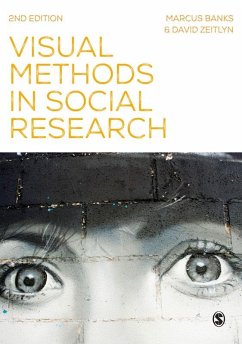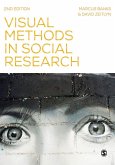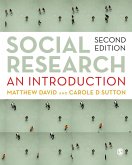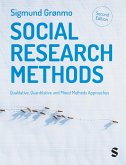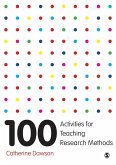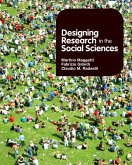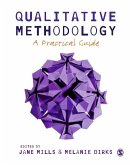46,95 €
46,95 €
inkl. MwSt.
Sofort per Download lieferbar

23 °P sammeln
46,95 €
Als Download kaufen

46,95 €
inkl. MwSt.
Sofort per Download lieferbar

23 °P sammeln
Jetzt verschenken
Alle Infos zum eBook verschenken
46,95 €
inkl. MwSt.
Sofort per Download lieferbar
Alle Infos zum eBook verschenken

23 °P sammeln
- Format: PDF
- Merkliste
- Auf die Merkliste
- Bewerten Bewerten
- Teilen
- Produkt teilen
- Produkterinnerung
- Produkterinnerung

Bitte loggen Sie sich zunächst in Ihr Kundenkonto ein oder registrieren Sie sich bei
bücher.de, um das eBook-Abo tolino select nutzen zu können.
Hier können Sie sich einloggen
Hier können Sie sich einloggen
Sie sind bereits eingeloggt. Klicken Sie auf 2. tolino select Abo, um fortzufahren.

Bitte loggen Sie sich zunächst in Ihr Kundenkonto ein oder registrieren Sie sich bei bücher.de, um das eBook-Abo tolino select nutzen zu können.
The Second Edition of this popular text confirms the book's status as an important forerunner in the field of visual methods.
Combining the theoretical, practical and technical the authors discuss changing technologies, the role of the internet and the impact of social media. Presenting an interdisciplinary guide to visual methods they explore both the creation and interpretation of visual images and their use within different methodological approaches.
This clear, articulate book is full of practical tips on publishing and presenting the results of visual research and how to use film…mehr
- Geräte: PC
- mit Kopierschutz
- eBook Hilfe
- Größe: 5.44MB
Andere Kunden interessierten sich auch für
![Visual Methods in Social Research (eBook, ePUB) Visual Methods in Social Research (eBook, ePUB)]() Marcus BanksVisual Methods in Social Research (eBook, ePUB)46,95 €
Marcus BanksVisual Methods in Social Research (eBook, ePUB)46,95 €![Social Research (eBook, PDF) Social Research (eBook, PDF)]() Matthew DavidSocial Research (eBook, PDF)60,95 €
Matthew DavidSocial Research (eBook, PDF)60,95 €![Social Research Methods (eBook, PDF) Social Research Methods (eBook, PDF)]() Sigmund GronmoSocial Research Methods (eBook, PDF)40,95 €
Sigmund GronmoSocial Research Methods (eBook, PDF)40,95 €![100 Activities for Teaching Research Methods (eBook, PDF) 100 Activities for Teaching Research Methods (eBook, PDF)]() Catherine Dawson100 Activities for Teaching Research Methods (eBook, PDF)55,95 €
Catherine Dawson100 Activities for Teaching Research Methods (eBook, PDF)55,95 €![Innovation in Mixed Methods Research (eBook, PDF) Innovation in Mixed Methods Research (eBook, PDF)]() Cheryl N. PothInnovation in Mixed Methods Research (eBook, PDF)46,95 €
Cheryl N. PothInnovation in Mixed Methods Research (eBook, PDF)46,95 €![Designing Research in the Social Sciences (eBook, PDF) Designing Research in the Social Sciences (eBook, PDF)]() Martino MaggettiDesigning Research in the Social Sciences (eBook, PDF)52,95 €
Martino MaggettiDesigning Research in the Social Sciences (eBook, PDF)52,95 €![Qualitative Methodology (eBook, PDF) Qualitative Methodology (eBook, PDF)]() Jane MillsQualitative Methodology (eBook, PDF)46,95 €
Jane MillsQualitative Methodology (eBook, PDF)46,95 €-
-
-
The Second Edition of this popular text confirms the book's status as an important forerunner in the field of visual methods.
Combining the theoretical, practical and technical the authors discuss changing technologies, the role of the internet and the impact of social media. Presenting an interdisciplinary guide to visual methods they explore both the creation and interpretation of visual images and their use within different methodological approaches.
This clear, articulate book is full of practical tips on publishing and presenting the results of visual research and how to use film and photographic archives.
This book will be an indispensable guide for anyone using or creating visual images in their research.
Combining the theoretical, practical and technical the authors discuss changing technologies, the role of the internet and the impact of social media. Presenting an interdisciplinary guide to visual methods they explore both the creation and interpretation of visual images and their use within different methodological approaches.
This clear, articulate book is full of practical tips on publishing and presenting the results of visual research and how to use film and photographic archives.
This book will be an indispensable guide for anyone using or creating visual images in their research.
Dieser Download kann aus rechtlichen Gründen nur mit Rechnungsadresse in A, D ausgeliefert werden.
Produktdetails
- Produktdetails
- Verlag: SAGE Publications
- Seitenzahl: 208
- Erscheinungstermin: 6. Juni 2015
- Englisch
- ISBN-13: 9781473926813
- Artikelnr.: 42893980
- Verlag: SAGE Publications
- Seitenzahl: 208
- Erscheinungstermin: 6. Juni 2015
- Englisch
- ISBN-13: 9781473926813
- Artikelnr.: 42893980
- Herstellerkennzeichnung Die Herstellerinformationen sind derzeit nicht verfügbar.
Marcus Banks is Professor of Visual Anthropoloigy at the University of Oxford. Having completed a doctorate in social anthropology at the University of Cambridge, with a study of Jain people in England and India, he trained as an ethnographic documentary filmmaker at the National Film and Television School, Beaconsfield, UK.
He is the author Using Visual Data in Qualitative Research (2007) and co-editor of Rethinking Visual Anthropology (1997, with Howard Morphy), and Made to be Seen: Perspectives on the History of Visual Anthropology (2011, with Jay Ruby), as well as publishing numerous papers on visual research.
He has published on documentary film forms and film practice in colonial India, and is currently conducting research on image production and use in forensic science practice.
He is the author Using Visual Data in Qualitative Research (2007) and co-editor of Rethinking Visual Anthropology (1997, with Howard Morphy), and Made to be Seen: Perspectives on the History of Visual Anthropology (2011, with Jay Ruby), as well as publishing numerous papers on visual research.
He has published on documentary film forms and film practice in colonial India, and is currently conducting research on image production and use in forensic science practice.
READING PICTURES
The trouble with pictures
An introductory example
Unnatural vision
Reading narratives
Formal readings
Planning a research project with visual methods
ENCOUNTERING THE VISUAL
On Television
Visual forms produced I: representations of society
Interpreting Forest of Bliss
Still and moving images
Visual forms produced II: representations of knowledge
Visualisation
Networks
Diagrams of Nuer lineages
Visual forms encountered
Encountering 'indigenous' media
The image as evidence
'Us' and 'them'?
MATERIAL VISION
Object and representation
The materiality of visual forms
Displaying family photographs
Exchanged goods
Market exchange
Size matters
Transformations: digitisation and computer-based media
Digital manipulation
Digital pornography: constraining the virtual
Digital pornography: exchange and circulation
RESEARCH STRATEGIES
Silk thread to plastic bags
Researching image use and production in social contexts
Watching television
Soap opera in India and Egypt
Television as social presence
Doing things with photographs and films
Photo-elicitation with archival images
Photo-elicitation with contemporary images
Learning from photo-elicitation
Film-elicitation
Working with archival material
Photographic archives and picture libraries
Film archives
MAKING IMAGES
Observing
Creating images for research
Documentation
A ladder climbed then discarded
Documentary exploration
Documentary control
Collaborative projects
Indigenous media collaborations
Collaborative after effects
Ethics and visual research
Ethical review
Permissions
Returning images
PRESENTING RESEARCH RESULTS
Audiences
Presenting photographs
The photographic essay
Presenting ethnographic and other films
Study guides and other contextualisation
Databases and digital images
Can computer see?
Multimedia projects
Interacting with Yanomamo
Copyright
PERSPECTIVES ON VISUAL RESEARCH
The state of visual research
The place of visual research
The nature of visual research
The trouble with pictures
An introductory example
Unnatural vision
Reading narratives
Formal readings
Planning a research project with visual methods
ENCOUNTERING THE VISUAL
On Television
Visual forms produced I: representations of society
Interpreting Forest of Bliss
Still and moving images
Visual forms produced II: representations of knowledge
Visualisation
Networks
Diagrams of Nuer lineages
Visual forms encountered
Encountering 'indigenous' media
The image as evidence
'Us' and 'them'?
MATERIAL VISION
Object and representation
The materiality of visual forms
Displaying family photographs
Exchanged goods
Market exchange
Size matters
Transformations: digitisation and computer-based media
Digital manipulation
Digital pornography: constraining the virtual
Digital pornography: exchange and circulation
RESEARCH STRATEGIES
Silk thread to plastic bags
Researching image use and production in social contexts
Watching television
Soap opera in India and Egypt
Television as social presence
Doing things with photographs and films
Photo-elicitation with archival images
Photo-elicitation with contemporary images
Learning from photo-elicitation
Film-elicitation
Working with archival material
Photographic archives and picture libraries
Film archives
MAKING IMAGES
Observing
Creating images for research
Documentation
A ladder climbed then discarded
Documentary exploration
Documentary control
Collaborative projects
Indigenous media collaborations
Collaborative after effects
Ethics and visual research
Ethical review
Permissions
Returning images
PRESENTING RESEARCH RESULTS
Audiences
Presenting photographs
The photographic essay
Presenting ethnographic and other films
Study guides and other contextualisation
Databases and digital images
Can computer see?
Multimedia projects
Interacting with Yanomamo
Copyright
PERSPECTIVES ON VISUAL RESEARCH
The state of visual research
The place of visual research
The nature of visual research
READING PICTURES The trouble with pictures An introductory example Unnatural vision Reading narratives Formal readings Planning a research project with visual methods ENCOUNTERING THE VISUAL On Television Visual forms produced I: representations of society Interpreting Forest of Bliss Still and moving images Visual forms produced II: representations of knowledge Visualisation Networks Diagrams of Nuer lineages Visual forms encountered Encountering
indigenous
media The image as evidence
Us
and
them
? MATERIAL VISION Object and representation The materiality of visual forms Displaying family photographs Exchanged goods Market exchange Size matters Transformations: digitisation and computer-based media Digital manipulation Digital pornography: constraining the virtual Digital pornography: exchange and circulation RESEARCH STRATEGIES Silk thread to plastic bags Researching image use and production in social contexts Watching television Soap opera in India and Egypt Television as social presence Doing things with photographs and films Photo-elicitation with archival images Photo-elicitation with contemporary images Learning from photo-elicitation Film-elicitation Working with archival material Photographic archives and picture libraries Film archives MAKING IMAGES Observing Creating images for research Documentation A ladder climbed then discarded Documentary exploration Documentary control Collaborative projects Indigenous media collaborations Collaborative after effects Ethics and visual research Ethical review Permissions Returning images PRESENTING RESEARCH RESULTS Audiences Presenting photographs The photographic essay Presenting ethnographic and other films Study guides and other contextualisation Databases and digital images Can computer see? Multimedia projects Interacting with Yanomamo Copyright PERSPECTIVES ON VISUAL RESEARCH The state of visual research The place of visual research The nature of visual research
indigenous
media The image as evidence
Us
and
them
? MATERIAL VISION Object and representation The materiality of visual forms Displaying family photographs Exchanged goods Market exchange Size matters Transformations: digitisation and computer-based media Digital manipulation Digital pornography: constraining the virtual Digital pornography: exchange and circulation RESEARCH STRATEGIES Silk thread to plastic bags Researching image use and production in social contexts Watching television Soap opera in India and Egypt Television as social presence Doing things with photographs and films Photo-elicitation with archival images Photo-elicitation with contemporary images Learning from photo-elicitation Film-elicitation Working with archival material Photographic archives and picture libraries Film archives MAKING IMAGES Observing Creating images for research Documentation A ladder climbed then discarded Documentary exploration Documentary control Collaborative projects Indigenous media collaborations Collaborative after effects Ethics and visual research Ethical review Permissions Returning images PRESENTING RESEARCH RESULTS Audiences Presenting photographs The photographic essay Presenting ethnographic and other films Study guides and other contextualisation Databases and digital images Can computer see? Multimedia projects Interacting with Yanomamo Copyright PERSPECTIVES ON VISUAL RESEARCH The state of visual research The place of visual research The nature of visual research
READING PICTURES
The trouble with pictures
An introductory example
Unnatural vision
Reading narratives
Formal readings
Planning a research project with visual methods
ENCOUNTERING THE VISUAL
On Television
Visual forms produced I: representations of society
Interpreting Forest of Bliss
Still and moving images
Visual forms produced II: representations of knowledge
Visualisation
Networks
Diagrams of Nuer lineages
Visual forms encountered
Encountering 'indigenous' media
The image as evidence
'Us' and 'them'?
MATERIAL VISION
Object and representation
The materiality of visual forms
Displaying family photographs
Exchanged goods
Market exchange
Size matters
Transformations: digitisation and computer-based media
Digital manipulation
Digital pornography: constraining the virtual
Digital pornography: exchange and circulation
RESEARCH STRATEGIES
Silk thread to plastic bags
Researching image use and production in social contexts
Watching television
Soap opera in India and Egypt
Television as social presence
Doing things with photographs and films
Photo-elicitation with archival images
Photo-elicitation with contemporary images
Learning from photo-elicitation
Film-elicitation
Working with archival material
Photographic archives and picture libraries
Film archives
MAKING IMAGES
Observing
Creating images for research
Documentation
A ladder climbed then discarded
Documentary exploration
Documentary control
Collaborative projects
Indigenous media collaborations
Collaborative after effects
Ethics and visual research
Ethical review
Permissions
Returning images
PRESENTING RESEARCH RESULTS
Audiences
Presenting photographs
The photographic essay
Presenting ethnographic and other films
Study guides and other contextualisation
Databases and digital images
Can computer see?
Multimedia projects
Interacting with Yanomamo
Copyright
PERSPECTIVES ON VISUAL RESEARCH
The state of visual research
The place of visual research
The nature of visual research
The trouble with pictures
An introductory example
Unnatural vision
Reading narratives
Formal readings
Planning a research project with visual methods
ENCOUNTERING THE VISUAL
On Television
Visual forms produced I: representations of society
Interpreting Forest of Bliss
Still and moving images
Visual forms produced II: representations of knowledge
Visualisation
Networks
Diagrams of Nuer lineages
Visual forms encountered
Encountering 'indigenous' media
The image as evidence
'Us' and 'them'?
MATERIAL VISION
Object and representation
The materiality of visual forms
Displaying family photographs
Exchanged goods
Market exchange
Size matters
Transformations: digitisation and computer-based media
Digital manipulation
Digital pornography: constraining the virtual
Digital pornography: exchange and circulation
RESEARCH STRATEGIES
Silk thread to plastic bags
Researching image use and production in social contexts
Watching television
Soap opera in India and Egypt
Television as social presence
Doing things with photographs and films
Photo-elicitation with archival images
Photo-elicitation with contemporary images
Learning from photo-elicitation
Film-elicitation
Working with archival material
Photographic archives and picture libraries
Film archives
MAKING IMAGES
Observing
Creating images for research
Documentation
A ladder climbed then discarded
Documentary exploration
Documentary control
Collaborative projects
Indigenous media collaborations
Collaborative after effects
Ethics and visual research
Ethical review
Permissions
Returning images
PRESENTING RESEARCH RESULTS
Audiences
Presenting photographs
The photographic essay
Presenting ethnographic and other films
Study guides and other contextualisation
Databases and digital images
Can computer see?
Multimedia projects
Interacting with Yanomamo
Copyright
PERSPECTIVES ON VISUAL RESEARCH
The state of visual research
The place of visual research
The nature of visual research
READING PICTURES The trouble with pictures An introductory example Unnatural vision Reading narratives Formal readings Planning a research project with visual methods ENCOUNTERING THE VISUAL On Television Visual forms produced I: representations of society Interpreting Forest of Bliss Still and moving images Visual forms produced II: representations of knowledge Visualisation Networks Diagrams of Nuer lineages Visual forms encountered Encountering
indigenous
media The image as evidence
Us
and
them
? MATERIAL VISION Object and representation The materiality of visual forms Displaying family photographs Exchanged goods Market exchange Size matters Transformations: digitisation and computer-based media Digital manipulation Digital pornography: constraining the virtual Digital pornography: exchange and circulation RESEARCH STRATEGIES Silk thread to plastic bags Researching image use and production in social contexts Watching television Soap opera in India and Egypt Television as social presence Doing things with photographs and films Photo-elicitation with archival images Photo-elicitation with contemporary images Learning from photo-elicitation Film-elicitation Working with archival material Photographic archives and picture libraries Film archives MAKING IMAGES Observing Creating images for research Documentation A ladder climbed then discarded Documentary exploration Documentary control Collaborative projects Indigenous media collaborations Collaborative after effects Ethics and visual research Ethical review Permissions Returning images PRESENTING RESEARCH RESULTS Audiences Presenting photographs The photographic essay Presenting ethnographic and other films Study guides and other contextualisation Databases and digital images Can computer see? Multimedia projects Interacting with Yanomamo Copyright PERSPECTIVES ON VISUAL RESEARCH The state of visual research The place of visual research The nature of visual research
indigenous
media The image as evidence
Us
and
them
? MATERIAL VISION Object and representation The materiality of visual forms Displaying family photographs Exchanged goods Market exchange Size matters Transformations: digitisation and computer-based media Digital manipulation Digital pornography: constraining the virtual Digital pornography: exchange and circulation RESEARCH STRATEGIES Silk thread to plastic bags Researching image use and production in social contexts Watching television Soap opera in India and Egypt Television as social presence Doing things with photographs and films Photo-elicitation with archival images Photo-elicitation with contemporary images Learning from photo-elicitation Film-elicitation Working with archival material Photographic archives and picture libraries Film archives MAKING IMAGES Observing Creating images for research Documentation A ladder climbed then discarded Documentary exploration Documentary control Collaborative projects Indigenous media collaborations Collaborative after effects Ethics and visual research Ethical review Permissions Returning images PRESENTING RESEARCH RESULTS Audiences Presenting photographs The photographic essay Presenting ethnographic and other films Study guides and other contextualisation Databases and digital images Can computer see? Multimedia projects Interacting with Yanomamo Copyright PERSPECTIVES ON VISUAL RESEARCH The state of visual research The place of visual research The nature of visual research
